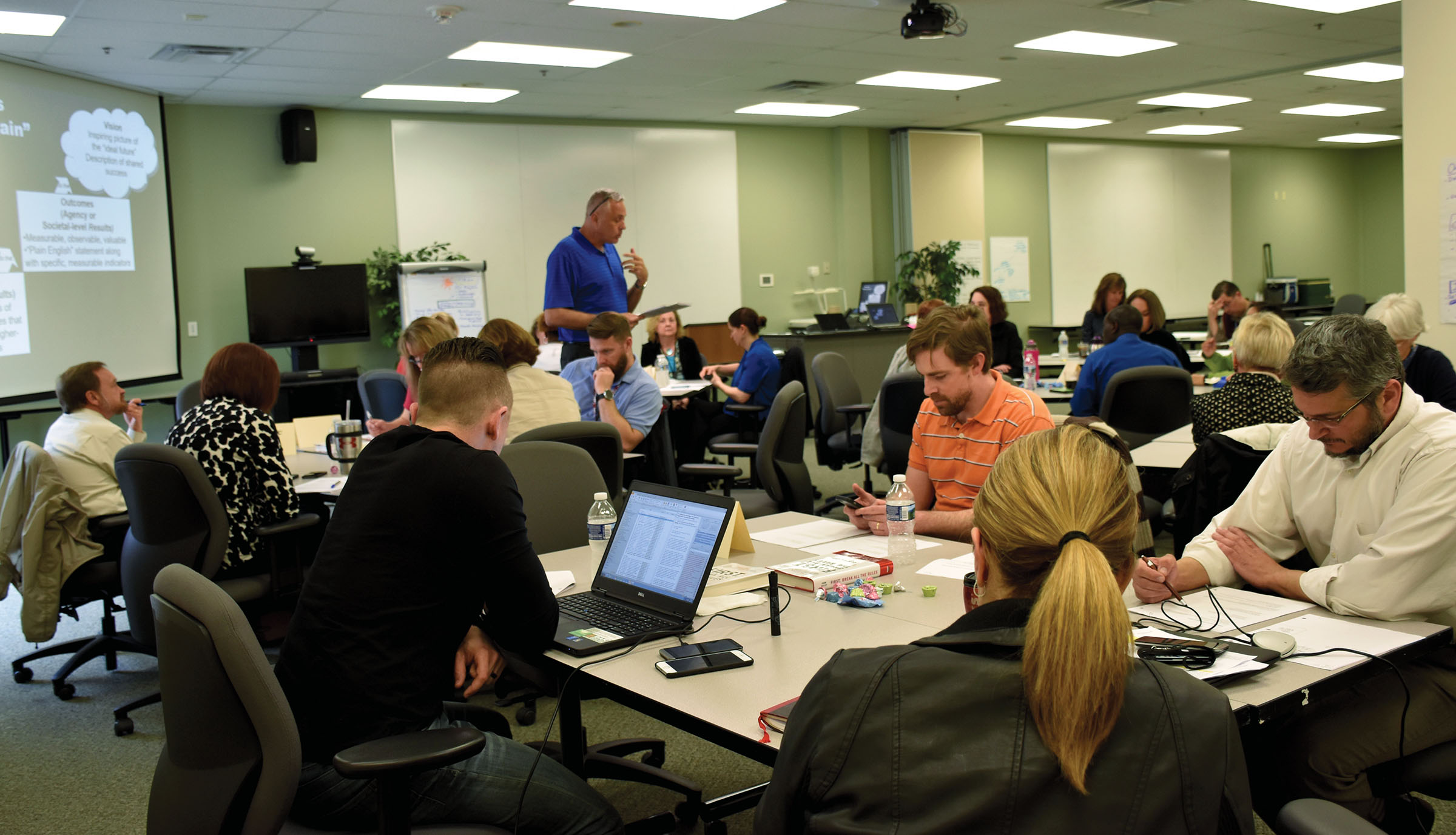
USAMMDA’s highly specialized workforce needs training to match its mission. It’s getting it, thanks to DAWDF funding.
by Ms. Kathleen L. Berst and Ms. Judy L. Holian
As the premier developer of world-class military medical capabilities, the U.S. Army Medical Materiel Development Activity (USAMMDA) at Fort Detrick, Maryland, is responsible for developing and delivering critical products for the nation’s military forces. USAMMDA requires a particular type of workforce to accomplish this mission, with skills not only in acquisition but also in very specialized areas of medical product development. These highly skilled personnel enable USAMMDA to supply products that protect and preserve the lives of warfighters worldwide.
The products include drugs, vaccines, blood products, devices and medical support equipment designed to maximize the survival of casualties on the battlefield. USAMMDA’s dedicated team focuses constantly on the timely delivery of new, affordable and sustainable capabilities.
Because of the variety of specialized knowledge and skills required for its mission, in 2014 USAMMDA implemented a multifaceted training program geared toward developing the workforce effectively in the key areas of technical and acquisition competency and leadership—and the results have been noteworthy. Given the financial constraints that exist throughout the federal government, USAMMDA has drawn on its creativity to provide the best training possible within a limited budget.
USAMMDA personnel possess distinct talents and areas of expertise that do not exist elsewhere in the acquisition enterprise. Most of its product and project managers have a scientific or engineering background in addition to the traditional business skill set often expected in these positions. USAMMDA personnel frequently interact with the U.S. Food and Drug Administration (FDA) and other regulatory agencies, clinical research entities and laboratories—again, not the typical lanes of the acquisition arena.

TEACHING TO LEAD
Participants in the inaugural USAMMDA Leadership Development Cohort Program work through in-class assignments with coach John Riordan, center, in March at USDA offices in Frederick. Riordan frames the training in various scenarios for the group to analyze and discuss. His mantra is, “Be yourself with more skill.” (Photos by Erin Bolling, USAMMDA Public Affairs)
INVESTING IN KNOWLEDGE
Within USAMMDA’s Regulatory Division, multiple staff members hold acquisition-coded positions because of their essential roles on integrated product teams for FDA-regulated products. Because USAMMDA’s unique segment of the acquisition world is evolving continuously, it is important to provide targeted, competency-based training to the team. Therefore, command leadership has sought various funding sources that allow USAMMDA to offer this specific coursework for its staff.
The Defense Acquisition Workforce Development Fund (DAWDF) has enabled USAMMDA to establish training in house to sustain and improve critical competencies in project management and regulatory affairs. DAWDF support has helped to develop USAMMDA personnel and prepare them to accomplish the mission. For example, Project Management Institute training has enabled more than 50 acquisition workforce members across the U.S. Army Medical Research and Materiel Command, USAMMDA’s higher headquarters, to achieve Project Management Professional certification, in addition to receiving Regulatory Affairs Certificate Program training.
While competency training is important, however, it is not enough to ensure mission success. Leadership development remains vital in enabling USAMMDA team members to work effectively outside their program-specific sphere of influence.
The government has excellent leadership and development programs, but they can cost upward of $10,000 per person, which is simply out of USAMMDA’s reach. Therefore, USAMMDA created its own program, leveraging internal resources and additional funding from DAWDF. Without DAWDF funds, USAMMDA’s training council could not have funded any of the recent offerings from a leading nonprofit educational institute or other efforts, including USAMMDA’s Leadership Development Cohort Program. Providing the cohort program in house has saved us a significant amount of money, compared with the cost of sending USAMMDA staff to an off-site, privately run program.

USAMMDA’s Leadership Development Cohort Program involves extensive reading and study between scheduled classes, and participants tackle many of the assignments as a group.
The Leadership Development Cohort Program comprises six sessions totaling eight full days. Tailored specifically to the unique needs of USAMMDA’s workforce and mission, and facilitated by a professional leadership coach, the program is being delivered to civilian product managers, deputy directors and branch chiefs over the course of eight months. They meet one day per month and have assignments in between.
Topics are based on the executive core qualifications identified by the U.S. Office of Personnel Management, such as leading people, achieving results, leading change, business acumen and building coalitions and partnerships. Thus the program offers USAMMDA team members the opportunity to align their various talents more effectively to meet any challenge within the organization’s unusual acquisition space. The focus is on distinguishing between managing and leading, to develop valuable skills that will help strengthen the organization.
What makes this program so effective is that the small group—26 participants in each cohort—moves through the training together. Members of the group support one another between meetings. There are assigned readings and books, TED Talks and various activities to complete before a scheduled session, and the camaraderie that comes from working on them together creates a positive atmosphere in the classroom.
Heightening participants’ engagement is the interaction of the group with the program coach, John Riordan. As a professional leadership instructor for nearly two decades, Riordan has been involved with the Excellence in Government Fellows and other government-based leadership programs. He connects with his clients quickly and guides each group by presenting real-world scenarios based on the specific work of the organization. His mantra, “Be yourself with more skill,” is one of the reasons USAMMDA chose to contract him for this program.
USAMMDA’s training council designed and structured the coursework to develop leadership capacity, starting with branch chiefs, deputy directors, product managers and selected nonmanagement staff members. The ultimate goal is to help everyone realize that they can contribute meaningfully on a daily basis, regardless of their pay grade, because the bottom line is that you do not have to be a senior staff member or a commander to be a leader.
With this emphasis on “leading at all levels,” the cohort learns that when a problem arises, it needs to be resolved, whether the person confronting it is the most junior member of the staff or the one in charge. As the coach advocates, you cannot just walk by a problem; it has to be addressed—and that is the point of this program.

DIRECT INTERACTION
Amy Brown, USAMMDA senior acquisition management liaison officer, receives feedback and guidance from Riordan on an in-class assignment for the Leadership Development Cohort Program. The complex, multifunctional nature of the organization’s work calls for leadership development at all levels.
TANGIBLE RESULTS
USAMMDA has seen the results of its leadership training in practical ways. In one case, the positive effect was evident almost immediately in the work of two participants during a classroom exercise.
As part of their prework during a recent executive training course, Strategies for Conflict Resolution, students were asked to provide a case study to discuss in class. As it happened, two people from different USAMMDA divisions had been experiencing ongoing stress from a joint work problem for which they could not agree on a solution.
They decided to use this real-life situation as their case study for class, and they wrote the assignment together. Bringing the paper to class, they allowed the course instructor to act as facilitator, along with the other participants, to work through their conflict. The result was successful: The two students reached a positive resolution that carried over into their daily business interactions, to the ultimate benefit of USAMMDA’s mission, which enlightened not only the two students but the entire class and the instructor.
As one of the two students involved said, “I really feel that the group setting was very beneficial in this case, because the other students—our peers—could remain neutral and objective, and they were able to offer helpful comments and suggestions. The conflict was not magically resolved, but we received some very valuable feedback that certainly helped to improve the situation.”
Even the Leadership Development Cohort Program, as valuable as it is to the growth of USAMMDA’s workforce, by itself may not be enough to fully cultivate the talents of the team within the organization’s unique space. Therefore, USAMMDA augments the program with invited guests, who speak on a variety of pertinent topics, and continuously looks for opportunities to send staff members on details and developmental assignments to broaden their skills and knowledge base in other areas of the organization, both internal and external to USAMMDA.
Mentorship remains a valuable component of USAMMDA’s training as well. Once the members of this current cohort, made up of senior staff, complete the program, they will be asked to serve as mentors to the junior staff during the next program offering.
USAMMDA plans to rotate each year between a Leadership Development Cohort Program geared toward senior staff and one geared to junior staff. Thus the training will help to develop the leadership skills of junior staff so they can progress eventually into senior roles, which will help strengthen USAMMDA’s bench and provide in-house candidates with the necessary skills for senior management positions.

ADDRESSING THE PROBLEM
Participants in USAMMDA’s inaugural Leadership Development Cohort Program work on a class assignment during a breakout session in March at U.S. Department of Agriculture (USDA) offices in Frederick, Maryland, near Fort Detrick. Coach John Riordan’s philosophy is that you cannot just bypass a problem; it has to be addressed. Thus the cohort learns that regardless of who identifies a problem—a junior staffer or the chief of the organization—it needs to be resolved, and people at all levels can be leaders in the effort.
CONCLUSION
USAMMDA understands the importance of talent management, and workforce development is a critical component of its strategic plan. The organization continues to formalize its training structure while building upon it.
The nature of the work requires multifunctional teams that must lead through influence, communicate effectively, and prevent, manage and resolve conflict. What USAMMDA does on a daily basis is so complicated that it requires many people to make that happen—it truly is a team effort. Therefore, ongoing leadership development at all levels is both beneficial and necessary.
Although it is important to make training opportunities available to staff members, it is equally imperative to have support at all levels of the command for this endeavor. The USAMMDA leadership team fully encourages the professional development of staff members, which helps put them at ease when they must take time away from their daily work to complete assigned training.
Col. William E. Geesey, USAMMDA’s commander, remains a faithful advocate of the Leadership Development Cohort Program and has addressed the group at multiple sessions.
“The primary mission of USAMMDA is to support our warfighters with whatever they need, whenever they need it, so they can complete their assigned missions successfully,” Geesey said. “This specific leadership training that we are providing to our USAMMDA team members will help us to accomplish our goal of protecting and preserving our military forces, which will benefit our entire nation in the end. It is certainly a win-win situation for all involved.”
With the implementation of a thoughtfully crafted training program, USAMMDA has already realized benefits as participants practice their skills in leading through influence and in preventing and managing conflict. The leadership remains dedicated to attracting, developing and aligning talent within this unique acquisition workforce to improve our ability to protect and preserve the lives of those defending our nation.
For more information on the work and mission of USAMMDA, go to http://www.usammda.army.mil.
MS. KATHLEEN L. BERST is deputy commander for acquisition at USAMMDA, responsible for oversight of five project management offices, one division and program support. She is currently completing an MBA from Hood College and holds a B.S. in molecular biology from Clarkson University. A member of the Army Acquisition Corps (AAC), she is Level III certified in program management. Additionally, Berst has achieved Project Management Professional certification and holds a Regulatory Affairs Certificate.
MS. JUDY L. HOLIAN is chief of USAMMDA’s Office of Research and Technology Applications, responsible for establishing technology transfer and interagency agreements to enable the advancement of biomedical research in support of medical solutions for the warfighter. She holds a B.S. in microbiology from The Pennsylvania State University. She is Level II certified in program management and a Project Management Professional, as well as a member of the AAC.
This article is scheduled to be published in the July-September 2017 issue of Army AL&T Magazine.
Subscribe to Army AL&T News, the premier online news source for the Acquisition, Logistics, and Technology (AL&T) Workforce.








